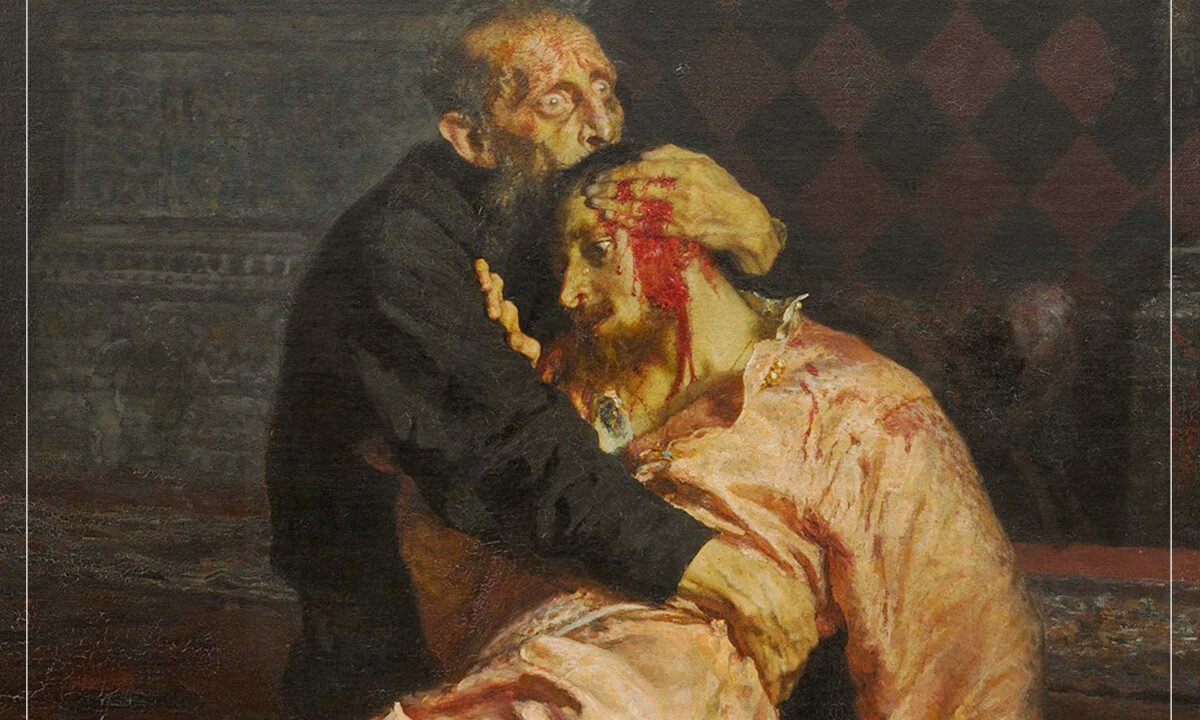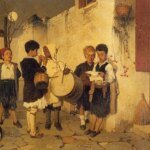

(Credits: Far Out / Tretyakov Gallery)
Between 1883 and 1885, the young Russian painter Ilya Repin painted his most famous work, Ivan The Terrible and His Son Ivan. Sure, the painting is ghastly and so harrowing that even when you google it, the image is blurred to shield viewers from what they are about to see. But we’ve all seen paintings, many even older than this one, like Caravaggio’s David with the Head of Goliath, that are just as gruesome. So why was this one deemed so terrible that it was banned from Russia?
For those who don’t know, the painting depicts Ivan IV Vasylievich, the first Tsar of Russia from 1547, in a critical moment with his dying son. The tsar was also known as ‘Ivan the Terrible’ for spearheading the creation of the Russian empire but at the immense cost of his own people.
Perhaps this nickname also fits the story of the painting. The most popular theory of the story is that the tsar killed his son, also called Ivan, in a moment of rage when his daughter-in-law, Yelena, was seen unsuitably dressed, leading to the altercation and subsequent death of his son, who tried to defend his wife.
If this potential story is true, which to me instinctively seemed like it was, then Repin had chosen to depict the moments right after the filicide itself. The blood is still fresh on Ivan’s face, and the spear used to hit him is still glistening in the light. The carpet is crumpled, and the chair is toppled, suggesting that the altercation had just happened.
We are immediately drawn to the grief-stricken tsar, whose petrified eyes bulge as if he’s suddenly come to his senses and is filled with regret and devastation. His white knuckles gleam like pearls in the pale light as he clenches onto his son, trying to bring him back to life. Repin has exquisitely rendered the physicality of the altercation by showing the tsar’s veins popping out on his temple and the deep wrinkles on his bloody face.

His gaunt and pallid complexion almost looks skull-like, foreshadowing his son’s ending. This expression is in stark contrast to that of the lifeless son Ivan, who has just enough energy to pull himself up and away from his murderer. The postures of the figures echo those in the infamous David and Jonathan by Rembrandt. This painting tells a similar story and, housed in the Hermitage Museum of Saint Petersburg, is one that Repin greatly admired.
However, unfortunately for Repin, his painting was deemed nowhere near as important as Rembrandt’s at the time. In 19th century Russia, painters, unlike authors and other creatives, were not recognised as scholarly individuals and thus excluded from the intelligentsia. This explains why his painting has so many theories surrounding it and no concrete story. Artworks had to be formally interpreted by critics because, unlike novels that were words on a page, paintings could be much more open to interpretation, which led to ambiguity, controversy and criticism.
This was especially the case for paintings that were thought to be denouncements of the status quo. Repin’s painting was thought to have been inspired by the assassination of Tsar Alexander II, which the artist had lived through firsthand. Although ‘Ivan the Terrible’ had lived 300 years prior, the subject matter seemed to resonate with the current political unrest during Alexander’s regicide. Konstantin Pobedonostsev, an advisor to Tsar Alexander and defender of conservatism in Russia, greatly opposed the display of the painting, deeming it inappropriate because a depiction of a tsar committing murder was going to tarnish the reputation of the monarchy.
So why was the painting thought to be cursed?
Many believe that the painting is cursed because it has been subject to multiple acts of iconoclasm throughout the years. It is as if viewers who come across the paintings enter a state of paranoia, leading them to commit unsolicited acts of violence. For example, in 1913, the painting was slashed by a mentally ill iconographer, and recently, in 2018, it was damaged again by a viewer who punctured the canvas with a metal pole.
In response to the events, Russian media outlets accused the attacker of being a Russian nationalist who saw the murder depicted as inaccurate and an age-old “smear campaign” of sorts to portray the Tsar as a bloodthirsty tyrant.
As a result, the painting had to be put away and restored through a “special restoration workshop”, which included a “unique restoration chair” to execute the restorations. Such restorations are estimated to have cost $160,000.
Just last year, after seven years of work, it was briefly unveiled to the press but brought back into the gallery’s vaults shortly after. The gallery has said that the painting will not be put in public exhibitions until a “protective capsule” has been built around it, similar to that of Botticelli’s The Birth of Venus in Florence’s Uffizi Gallery.
However, this ‘cursed’ painting risks remaining in darkness forever. Such bulletproof capsules are rare to find, and with the current sanctions on Russia due to the war in Ukraine, it seems like the painting won’t see the light of day for a while. Perhaps it’s for the best.
Related Topics











